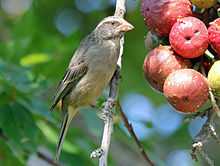Streaky-headed Seedeater
| Streaky-headed Seedeater | |
|---|---|
.jpg) | |
| Pietermaritzburg, South Africa | |
| Conservation status | |
| Scientific classification | |
| Kingdom: | Animalia |
| Phylum: | Chordata |
| Class: | Aves |
| Order: | Passeriformes |
| Family: | Fringillidae |
| Genus: | Serinus |
| Species: | S. gularis |
| Binomial name | |
| Serinus gularis (Smith, 1836) | |
| Synonyms | |
|
Crithagra gularis | |

The Streaky-headed Seedeater or Streaky-headed Canary (Serinus gularis) is a small passerine bird in the finch family. It is a common resident breeder in suitable habitat in much of Africa south of the Sahara.
Its habitat is open woodland and scrub, including savanna, orchards, and gardens. It builds a compact cup nest in a scrub.
The Streaky-headed Seedeater is 13–14 cm in length. The adult has brown upperparts with some faint streaking and a plain brown rump. The head has a finely white-streaked crown, dark face, and white supercilium and chin. The underparts are warm buff. The sexes are similar, but some females show a little breast streaking. The juvenile has less head streaking, a dull supercilium, more heavily streaked upperparts, and heavy streaking on the pale grey underparts.
There are nine recognized subspecies, differing mainly in the colour shade of the upperparts and underparts. humilis of the southwestern Cape has almost unstreaked upperparts, and S. g. reichardi, (southern Zaire to southern Tanzania and northern Mozambique) has a distinctly streaked breast even in adult plumage.
The subspecies canicapilla of West Africa is sometimes split as the West African Seedeater, Serinus canicapilla (Du Bus de Gisignies, 1855).
The Streaky-headed Seedeater is usually seen in pairs, but can be gregarious, forming large flocks, alone or with other canary species. It feeds on soft fruit, weed seeds and buds, and sometimes takes insects. Large flocks can damage sunflower, millet and other cereal crops.
This is an unobtrusive finch, often perching inside bushes. Its call is a soft tseee, and the song is a wit-chee-chee-chee-cha cha cha cha chip, interspersed with mimicry of other species. There is also a tweu tweu tirrirrit-tink given in display flight.
References
- ↑ BirdLife International (2012). "Serinus gularis". IUCN Red List of Threatened Species. Version 2013.2. International Union for Conservation of Nature. Retrieved 26 November 2013.
- Ian Sinclair, Phil Hockey and Warwick Tarboton, SASOL Birds of Southern Africa (Struik 2002) ISBN 1-86872-721-1
- Clement, Harris and Davis, Finches and Sparrows by ISBN 0-7136-8017-2
